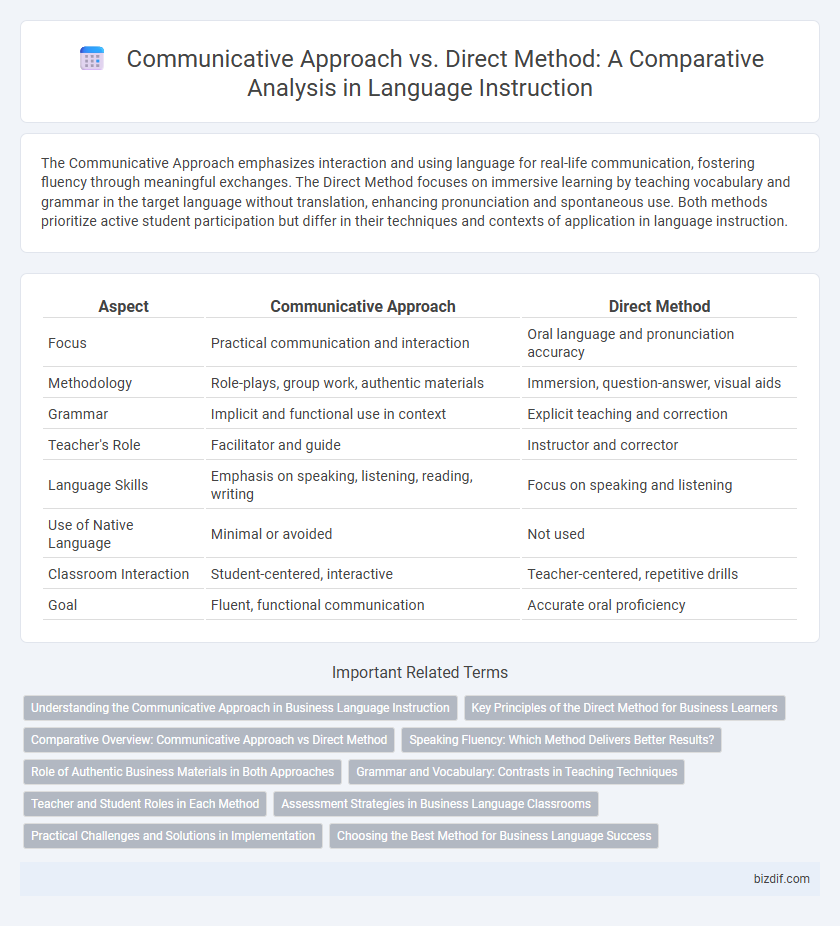The Communicative Approach emphasizes interaction and using language for real-life communication, fostering fluency through meaningful exchanges. The Direct Method focuses on immersive learning by teaching vocabulary and grammar in the target language without translation, enhancing pronunciation and spontaneous use. Both methods prioritize active student participation but differ in their techniques and contexts of application in language instruction.
Table of Comparison
| Aspect | Communicative Approach | Direct Method |
|---|---|---|
| Focus | Practical communication and interaction | Oral language and pronunciation accuracy |
| Methodology | Role-plays, group work, authentic materials | Immersion, question-answer, visual aids |
| Grammar | Implicit and functional use in context | Explicit teaching and correction |
| Teacher's Role | Facilitator and guide | Instructor and corrector |
| Language Skills | Emphasis on speaking, listening, reading, writing | Focus on speaking and listening |
| Use of Native Language | Minimal or avoided | Not used |
| Classroom Interaction | Student-centered, interactive | Teacher-centered, repetitive drills |
| Goal | Fluent, functional communication | Accurate oral proficiency |
Understanding the Communicative Approach in Business Language Instruction
The Communicative Approach in business language instruction emphasizes real-life communication skills by prioritizing interaction, negotiation, and practical language use in workplace scenarios over rote memorization. This method fosters fluency and comprehension through role-plays, simulations, and authentic materials tailored to business contexts, enhancing learners' ability to navigate meetings, presentations, and negotiations effectively. Unlike the Direct Method, which focuses on vocabulary and grammar through repetition, the Communicative Approach integrates cultural nuances and pragmatic language functions critical for global business communication.
Key Principles of the Direct Method for Business Learners
The Direct Method for business learners emphasizes immersive language acquisition through exclusive target language use, prioritizing oral communication and practical vocabulary relevant to business contexts. Key principles include spontaneous speaking practice, immediate correction of errors to reinforce accuracy, and contextual learning through real-life business scenarios such as meetings, negotiations, and presentations. This method fosters natural fluency and confidence by integrating business-specific terminology and interactive dialogues tailored to professional environments.
Comparative Overview: Communicative Approach vs Direct Method
The Communicative Approach emphasizes interaction and real-life communication, prioritizing functional language use and learner-centered activities, whereas the Direct Method focuses on immersive language exposure through oral practice and strict avoidance of the learner's native language. In comparison, the Communicative Approach integrates listening, speaking, reading, and writing skills simultaneously, promoting fluency and accuracy, while the Direct Method primarily targets spoken fluency and accurate pronunciation through repetitive drills and visual aids. Research indicates the Communicative Approach yields better learner engagement and long-term communicative competence, whereas the Direct Method is effective for foundational oral skills and immersion in early language stages.
Speaking Fluency: Which Method Delivers Better Results?
The Communicative Approach emphasizes real-life interaction and spontaneous communication, significantly improving speaking fluency by encouraging learners to use language in authentic contexts. The Direct Method prioritizes immersion through target language-only instruction, fostering accurate pronunciation and immediate speech responses. Research indicates that the Communicative Approach generally delivers better results in speaking fluency due to its focus on meaningful communication and learner engagement.
Role of Authentic Business Materials in Both Approaches
Authentic business materials play a crucial role in both the Communicative Approach and the Direct Method by providing learners with real-world contexts that enhance practical language use. In the Communicative Approach, these materials facilitate interactive tasks that mimic workplace communication, fostering genuine conversational skills. The Direct Method utilizes authentic business resources to immerse students in natural language input, promoting spontaneous speaking and listening proficiency essential for professional settings.
Grammar and Vocabulary: Contrasts in Teaching Techniques
The Communicative Approach emphasizes using grammar and vocabulary in meaningful contexts, encouraging learners to develop practical communication skills through interactive activities. In contrast, the Direct Method prioritizes immediate immersion by teaching grammar inductively and vocabulary orally without translation, focusing on speaking and listening accuracy. These distinct techniques highlight the Communicative Approach's goal of fluency over form, while the Direct Method concentrates on precision in language structure and pronunciation.
Teacher and Student Roles in Each Method
In the Communicative Approach, teachers act as facilitators, promoting interaction and real-life communication, while students actively participate by negotiating meaning and using language in authentic contexts. The Direct Method positions teachers as primary language models, emphasizing oral skills and immediate correction, with students expected to respond quickly and mimic natural language use. Both methods prioritize student engagement but differ in teacher authority and the balance between fluency and accuracy in language acquisition.
Assessment Strategies in Business Language Classrooms
Assessment strategies in business language classrooms differ significantly between the Communicative Approach and the Direct Method; the Communicative Approach emphasizes performance-based evaluations such as role-plays, simulations, and real-life business interactions to assess practical communication skills. In contrast, the Direct Method focuses on oral proficiency and spontaneous speaking through immediate correction and repetitive practice, using oral exams and drills to measure language accuracy and fluency. Both approaches prioritize authentic language use but diverge in assessment focus, with the Communicative Approach targeting interactive competence and the Direct Method stressing pronunciation and grammatical accuracy.
Practical Challenges and Solutions in Implementation
Implementing the Communicative Approach faces practical challenges such as large class sizes and limited authentic materials, which hinder interactive and real-life communication practice. The Direct Method struggles with learners' varying levels of oral proficiency and teachers' need for extensive training in spontaneous speaking techniques. Solutions include incorporating technology for simulation exercises and ongoing teacher development programs focusing on adaptive interaction strategies.
Choosing the Best Method for Business Language Success
The Communicative Approach prioritizes interaction and real-life communication skills, making it ideal for business professionals who need to negotiate, present, and collaborate effectively. The Direct Method emphasizes immersion and natural language acquisition, which can accelerate vocabulary retention and pronunciation accuracy essential for international business settings. Choosing the best method depends on whether the goal is practical communication fluency or rapid language immersion to meet specific business objectives.
Communicative Approach vs Direct Method Infographic

 bizdif.com
bizdif.com